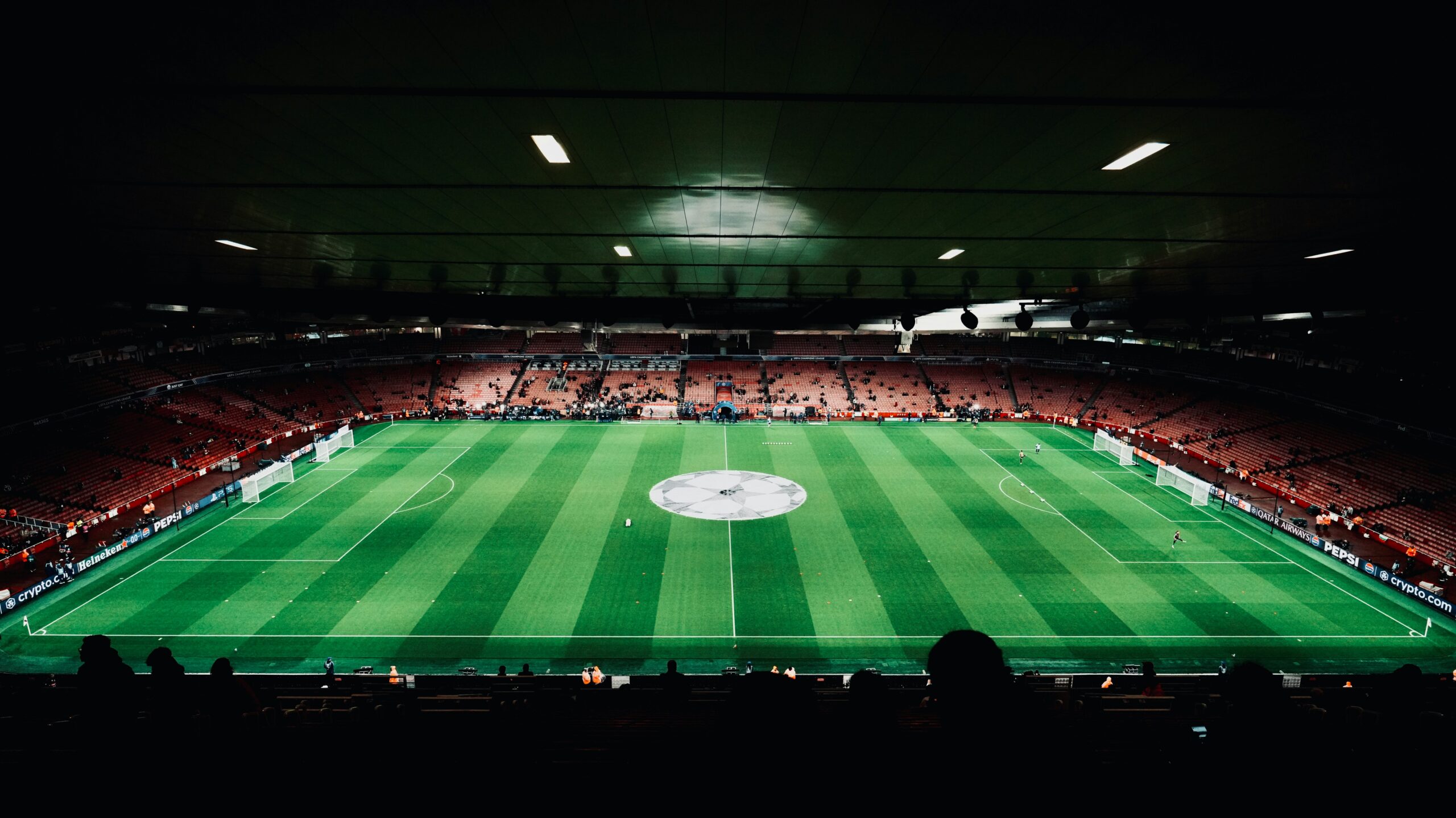
APFA
April 11, 2025
A Team Triumph and a Solo Show: Arsenal’s 3-0 Victory Over Real Madrid
Arsenal’s attacking build up versus Real Madrid’s defensive press:
Arsenal started the game with their usual style in their own third, playing out with a 2-3 base in front of David Raya. In front of their two centre backs, both fullbacks generally inverted to create a three man deep lying midfield. Kiwior and Saliba would play deeper in possession and would look to play shorter distance passes into any of the three in front of them whilst guaranteeing a defensive balance should any transition moments arise.
Thomas Partey would hold down the central area and play between the Real Madrid’s front two, receiving between and behind either Mbappe or Vinicius Junior. Lewis-Skelly and Timber would narrow inside as holding midfielders leaving passing lanes open for the centre backs on the outside of Madrid’s front two as well centrally through Partey.
Real Madrid set up in a 4-4-2 shape without the ball, Mbappe and Vinicius Junior would allow the two Arsenal centre backs to have the ball. Behind them the midfield four were set to jump and press any passes into the ‘midfield three’ of Partey, Timber or Lewis-Skelly.
This sounds an even match up with Madrid’s plan being that when passes from the centre backs went into the Arsenal midfield, Madrid’s central midfield pairing of Camavinga or Modrić could press man to man with Bellingham and Rodrygo then narrowing the pitch accordingly making the play predictable.
Arsenal’s trump card when building up:
Arsenal often created a five versus two in possession against Mbappe and Vinicius Junior. This meant that any time Madrid’s two up front engaged in a press, Arsenal midfielders would move to receive between Real Madrid’s defensive lines of pressure, receiving on the half turn and facing forward.
There wasn’t just a five versus two to contend with for the Madrid pressing structure:
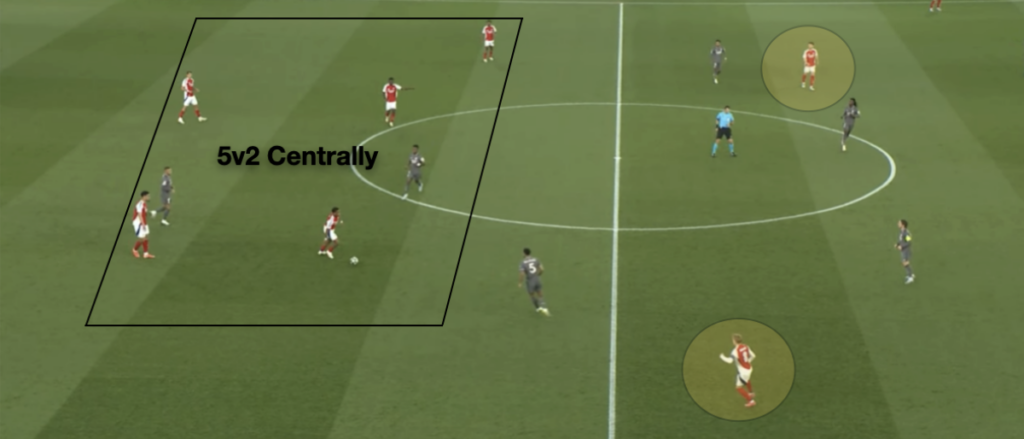
Arsenal’s five versus two in possession with Bellingham jumping late to press Jurien Timber. Ødegaard stays on the outside of Madrid’s midfield and Rice and Merino play between and behind the Madrid midfield block: leaving passing lanes centrally and wide for Timber in possession.
A key detail in the tactical battle on this front was the positions taken up by Arsenal’s higher midfielders Declan Rice and Martin Ødegaard and their auxiliary number nine Mikel Merino. Depending on what side the possession was kept: Arsenal would have a higher midfielder play on the outside of the Real Madrid’s midfield block. Behind the Madrid Midfield then? Merino would play in the half spaces, dropping so deep that neither of the Galácticos centre backs; Antonio Rüdiger or Raúl Asencio were willing to follow him.
Who presses who?
As soon as this question became a real debate amongst Madrid’s midfielder four, Arsenal really started to control and dominate the build up phase and ultimately the tempo and momentum of the game.
Previously Bellingham had tried to press Lewis Skelly inside but the full back had an easy outlet in Ødegaard who received and turned out wide with time and space to progress possession forward to Saka. The next big pressing decision is punished even more by Arsenal. Rodrygo tries to force the issue and jumps to press Lewis-Skelly inside. Through an excellent disguised turn from Lewis-Skelly, Arsenal are now comfortably past Madrid’s front two. Lewis-Skelly is facing forward with both Merino and Rice unmarked and playing off the shoulders of Modric and Camavinga, with Bellingham and Rodrygo also out of the game.
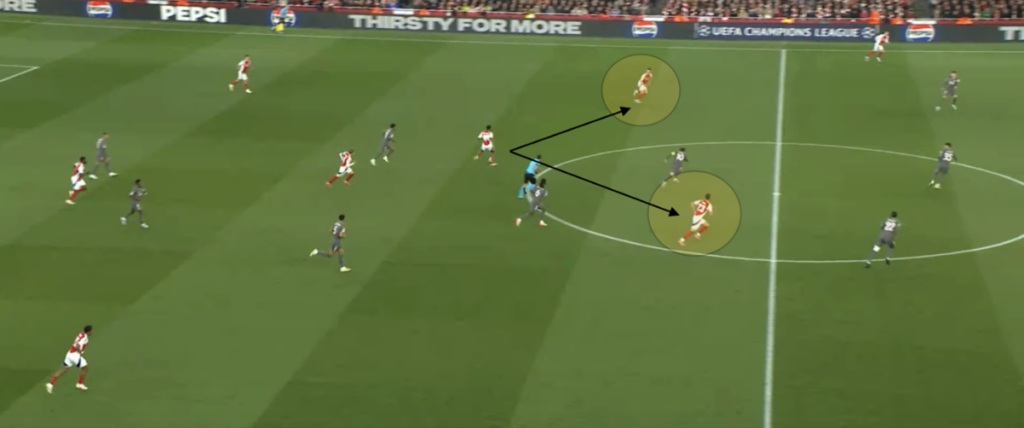
Lewis-Skelly with time and space facing forward and Rice and Merino in positions to receive. Rodrygo and Bellingham, alongside Mbappe and Vinicius Junior are now out of shape from a defensive point of view with Arsenal breaking forward yet again from a build-up moment.
Arsenal in the final third:
Arsenal’s attacking style in the final third was predominately led in a tactical sense by the same two players who caused Real Madrid so many issues in the build up phase. Once Arsenal did find themselves in the final third, they often played to their wingers Bukayo Saka and Gabriel Martinelli. Once these passes to feet were made, it was the dynamic duo of Ødegaard and Rice who made direct runs between the opposition’s fullbacks and centre backs where they again created an issue for Real Madrid.
The centre backs were not very eager to move outside the width of the box, meaning that Madrid’s wide midfielders had to track their runs, creating space for Martinelli and Saka to drive at their opposite fullback one versus one or come inside with possession.
Bukayo Saka needed no second invitation. He used the space created through Ødegaard’s positioning time and time again, running at David Alaba one versus one relentlessly.
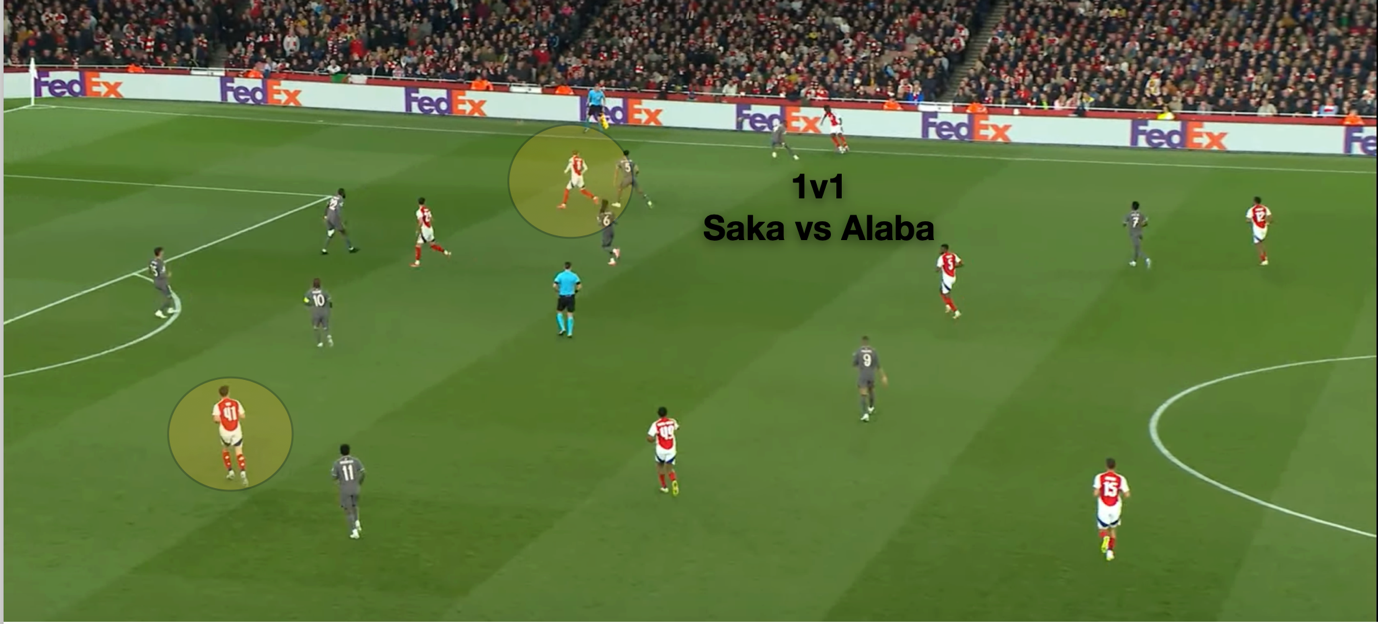
Ødegaard and Rice occupying spaces between Madrid’s midfield and fullbacks particularly on the same side, allowing Saka time and space against Alaba. This is just moments before Saka begins dribbling infield at pace ultimately winning a free kick for Arsenal; one Declan Rice would whip into the back of the net spectacularly!
Arsenal in the final third continued:
Rice and Ødegaard successfully create another attacking moment through their third man running, positioning themselves between Madrid’s centre backs and fullbacks. This time it is Rice on the left-hand side who is followed by Camavinga. This creates more space for Arsenal in possession centrally with Kiwior stepping up the pitch before playing a pass into Rice’s feet to inside the Madrid penalty area.
Rather than the ball going wide to Martinelli, this time Arsenal combine centrally with Rice and Lewis-Skelly working together to create their teams best attacking moment of the game from open play. Ultimately Real Madrid keep Arsenal out, moments later, thanks to the outstanding Thibaut Courtouis who makes a double save either side of David Alaba’s goal line clearance.
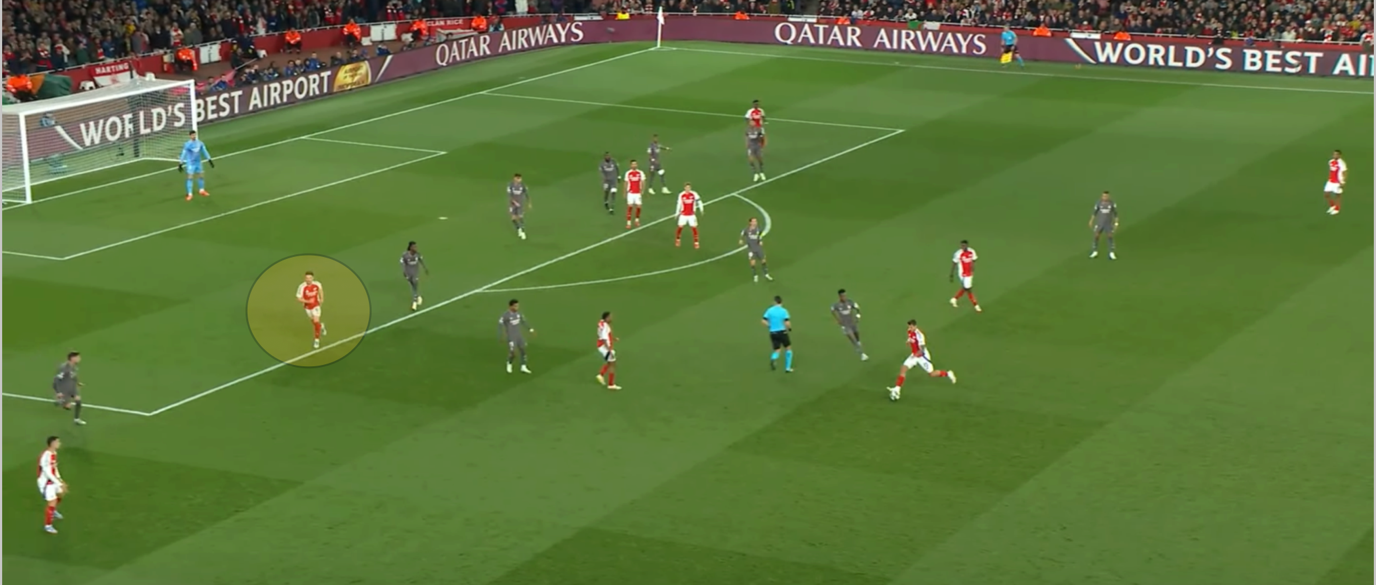
Arsenal are now well on top in the tie, dominating the game tactically both in possession and in chance creation, whilst Real Madrid retreat further back into their own half with little opportunity to counter attack.
The final piece of the tactical puzzle:
From a cynic’s point of view, Arsenal’s first two goals coming from tactical brilliance could be considered a stretch. Irrelevant of how Arsenal won their free kicks, it took two truly special strikes from Declan Rice for Arsenal to gain their advantage. The third goal though, left little doubt about how good Arsenal really were tactically in the final third.

Third man running and one versus one on the flanks was a big part of the Gunner’s tactical plan to disrupt Real Madrid’s defensive block. It was Mikel Merino’s false nine position that proved the hardest to manage for ‘Los Meringues’. He constantly evaded the attention of Real Madrid’s centre backs and this paid dividends in the 74th minute when Arsenal took a three-nil lead.
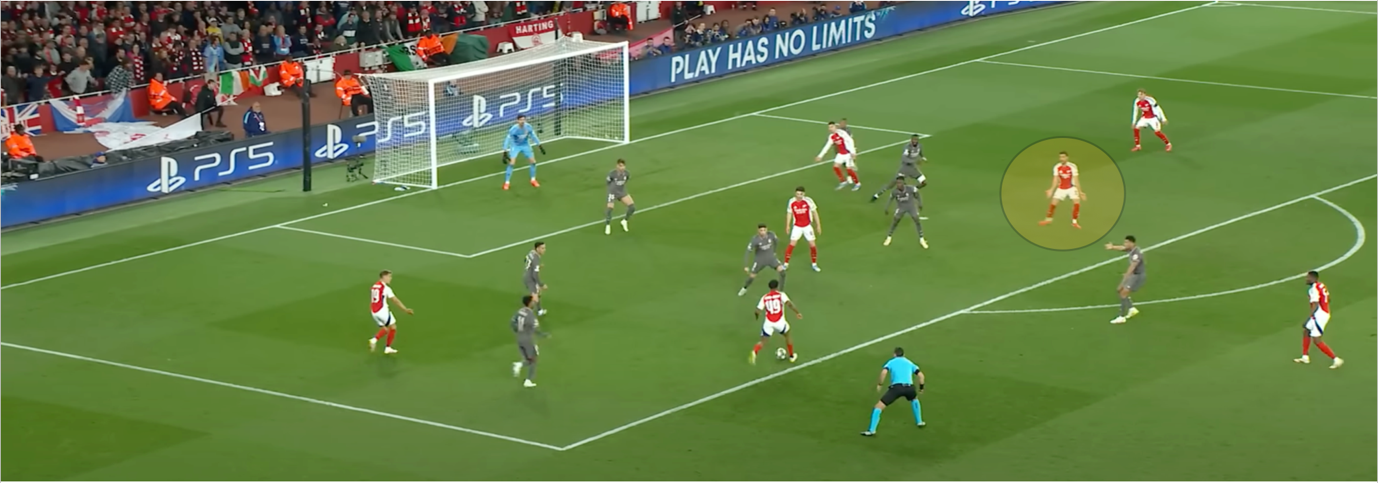
Mikel Merino Receiving the ball facing forward and between lines early in the build up phase. Moments later Merino in Madrid’s box, free to receive and score Arsenal’s third goal of the tie!
Arsenal top defending versus Real Madrid’s toothless attacking:
Scoring was vitally important in the tie for Arsenal before travelling to the Bernabéu for the second leg. It should not be forgotten how vital their clean sheet could be. The lack of chances created from Real Madrid, came down to two key factors.
1) Arsenal’s balance behind the ball on transition to defend:
Mikel Arteta is known to prioritise control and territorial dominance as a tactical preference when it comes to his philosophy as a coach. This has proven to be costly at some points this season, against opposition who are happy to sit into a block against Arsenal such as premier league rivals Fulham, Everton and Newcastle in the Carabao Cup.
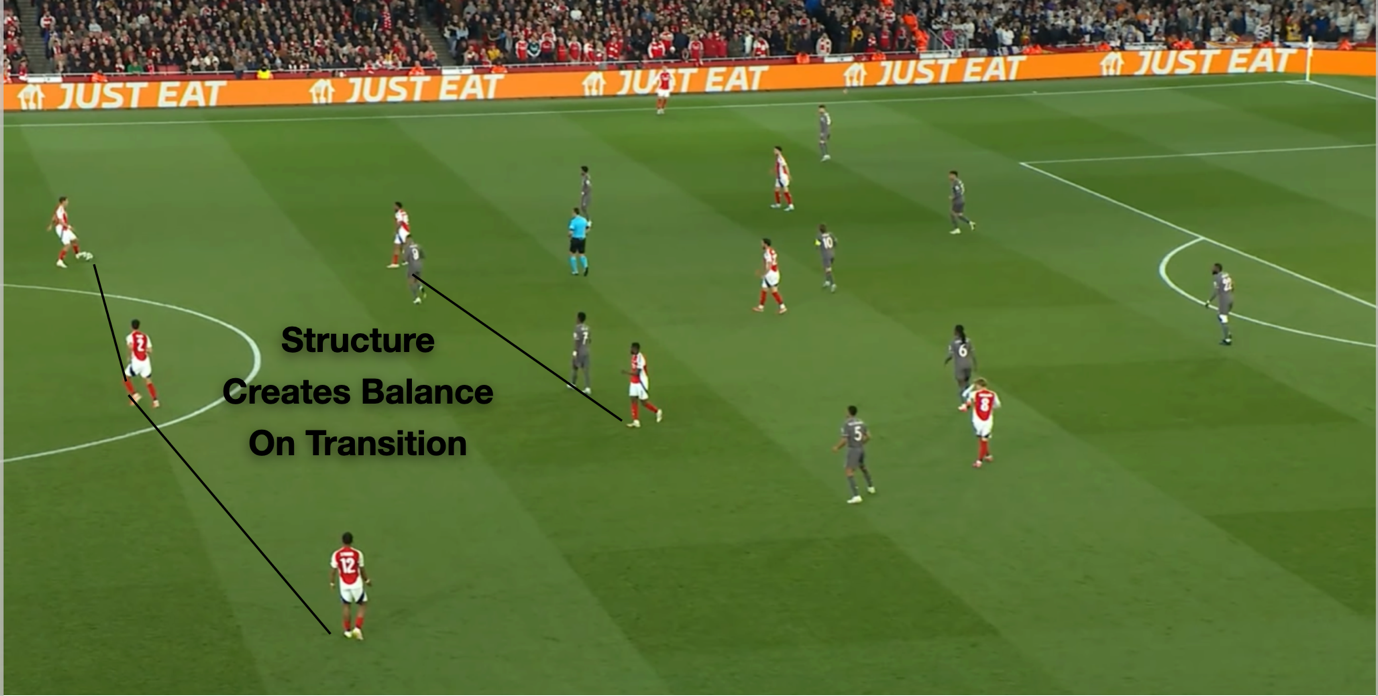
Safety in numbers, Arsenal leave little to chance on transition to defend.
2) Real Madrid’s lack of numbers versus Arsenals low block:
Arsenal were happy to surrender possession when Real Madrid did control possession in their half. Arsenal dropped off into a 4-4-2 block and on occasion a 5-3-2 or 5-4-1 formation with Saka or Martinelli willing to double up defensively against Real Madrid’s wide players.
Real Madrid may live to regret that they committed so few numbers in between or in behind Arsenal’s defensive block. Kylian Mbappe and Vinicius Junior cut frustrated figures throughout the tie whilst Real Madrid kept their central defenders, central midfielders and their fullbacks underneath the play prepared to recycle the ball from side to side without any penetration or imagination.
This meant that Arsenal often had all eleven players in a narrow compact block with little or no room for a star-studded attacking line to create or combine.
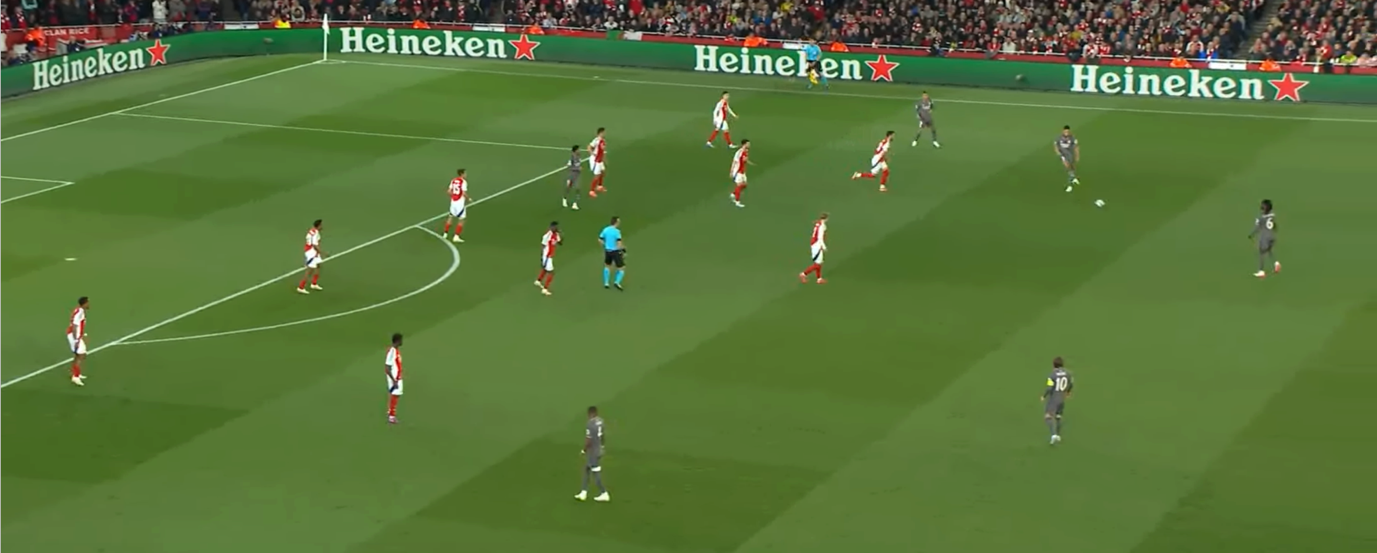
Real Madrid playing it too safe; a lack of forward passing options led to a passive attacking display!
To conclude:
This was an outstanding European night from an Arsenal point of view, where tactical brilliance and individual genius worked in tandem. Arsenal put together just about the best performance their coaching staff could have conjured up in their dreams and yet, Declan Rice stole the show with two astonishing strikes.
In theory, the tie should be all but over now but history has proven that, Real Madrid are never quite out of the competition when there is still football to be played!
Written by APFA Member, James Toner
Want to Break Down a Game as Expertly as James Does in This Article?
Our online courses offer unmatched guidance across key areas of football analysis, helping you sharpen your skills and earn a certification to advance your development as an analyst.
